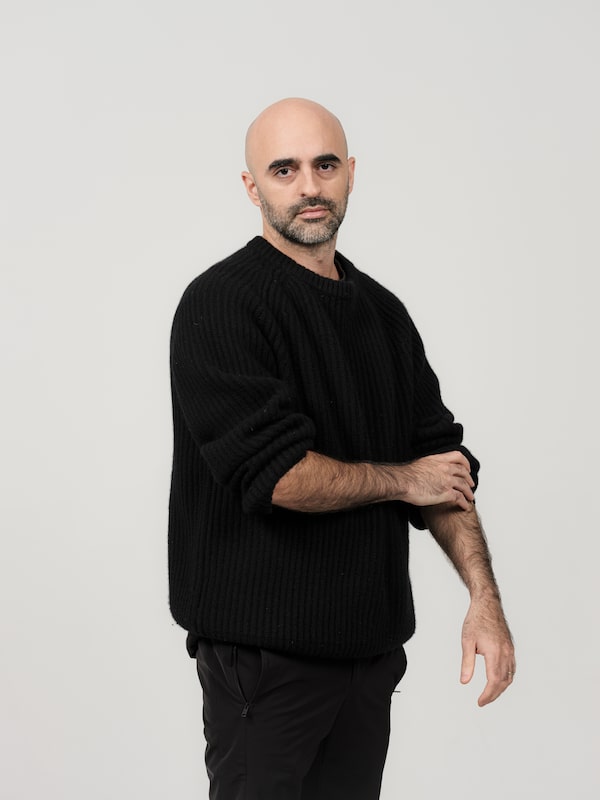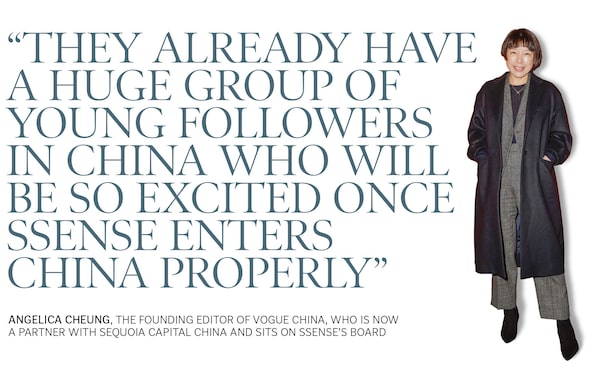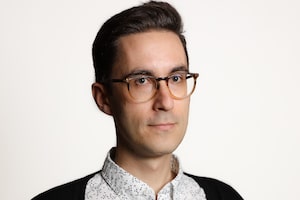This story is part of our annual CEO of the Year package. Each year, Report on Business magazine recognizes five business leaders who have made outstanding contributions to Canada.

Alexi Hobbs/The Globe and Mail
- The Newcomer
- The corporate citizen
- The Innovator
- The Strategist
- The Global Visionary
CEOs of the year
There was a time when Rami Atallah practically had to beg for attention. In 2008, he was running Ssense, a fledgling online fashion retailer in Montreal, and had decided to switch from selling mainstream apparel to luxury garments. There were two problems: Nobody knew who he was, and Atallah himself barely knew who the big industry players were. His research of the luxury market eventually led him to the head office of Balmain, a fashion house in Paris.
Alain Hivelin had rescued Balmain a few years earlier, overseeing a move from selling classy blazers to crystal-bedazzled ripped jeans and other rock star–inspired garments. Atallah, then in his mid-twenties, wanted to convince Hivelin to make Balmain’s clothing available for sale on Ssense. He had an appointment with a salesperson but wanted to speak with the CEO personally, so he lingered outside Hivelin’s door all day, through lunch and multiple meetings, until the CEO finally took pity. Atallah told him about Ssense and how consumers were eager to buy luxury fashion online. In Atallah’s telling, his persistence reminded Hivelin of his own youthful grit, and he came around to the idea. Atallah clinched the deal. (Hivelin died in 2014.)
Atallah no longer has to pine outside the doors of the fashion elite. Ssense is a sprawling multibillion-dollar mainstay in luxury fashion that carries more than 700 brands for a growing international fan base. The company operates on a wholesale model and offers names you would expect, such as Balenciaga and Versace, along with lesser knowns desired by a wealthy subset of consumers who view clothing as art, identity and a marker of status. It’s probably the only place you can buy a vegan-leather monogrammed beret from a Polish streetwear brand, a $6,000 Givenchy handbag and luxury lounge pants from an “anonymous Seoul-based design collective,” and have it shipped to your door within a couple of days. More recently, Ssense added a section called “Everything Else” that includes kids apparel, pet products and home decor.
Atallah, 39, oversees Ssense and its 1,500 employees (including temp staff) with his brothers, Firas and Bassel, who serve as chief governance and chief operations officers. (Atallah is the middle sibling.) They were early to see the potential of online fashion retail, especially for high-end products. Luxury retailers have long traded on exclusivity and were slow to move online, allowing Ssense to prosper. “We just realized the luxury space had more demand and less distribution,” Atallah says.
Since launching the site in 2006, Atallah has grown the company by curating a broad but calculated selection of designers, implementing unfussy design and shaping Ssense into its own brand. The name carries a certain mystique that’s hard to define, other than to say it radiates a sophisticated coolness. Despite its size, Ssense still straddles a tenuous line between underground and mass brand; it’s a fixture for those in the know, but may draw blank stares from everyone else.
The next few years could be transformative—and risky—for Ssense. The company took on external funding for the first time this year from Sequoia Capital China that valued it at more than $5 billion. Having a minority investor also means Ssense, essentially a cloistered family-run company, has to open up to outsiders. The board has long consisted of Atallah, his brothers and both parents, but a partner from Sequoia has since joined. With the funding, Ssense plans to make a deeper push into China, a challenging market for foreign companies. Plus, it wants to launch its own clothing brands for the first time next year. “So,” Atallah smiles, “there’s a lot at stake.”
For those whose sartorial choices lean normcore, browsing Ssense is like slipping into an alternate fashion universe where everything is familiar but just a bit off. Questions arise. Why is that T-shirt $650? Are those $1,690 women’s pants...crocheted? Where does one wear an $11,000 green shearling robe? And should one pair it with the $930 matching gloves that resemble yeti paws?
The aesthetic is minimalist, and Ssense models are always photographed on a pure white background with no shadows or anything else to suggest a connection to earthbound physics. No one smiles. The models wear the dissociative look of those who have gazed into the abyss and seen the abyss gaze back. Even the child models wearing $970 cashmere cardigans appear glum. The exception is a shiba inu who seems absolutely delighted to sport a $935 denim harness.
Every item—about 120,000 per year—is photographed in studios at company headquarters. Ssense styles complete outfits, including hair and makeup, and the final presentation is more akin to a fashion magazine than an online retailer. The approach is more expensive, Atallah says, but it helps establish an identity. “People tell us they can see a photo from Ssense anywhere on the web and know it’s us,” he says.

Those photos are an endless source of longing for Ssense customers. Ciera Parker, a 27-year-old in New York, has always loved style. A well-curated outfit can move her in the same way a painting may set hearts aflutter. She made her first Ssense purchase, a pair of Raf Simons sneakers, a few years ago and has been a loyal customer ever since. “I was hooked,” she says. Parker browses Ssense daily for style inspiration, just as she would Instagram, but limits her purchases to once a month. “It’s like the Apple of shopping. It’s just seamless,” she says. “Y’all got me, Canada.”
Parker is far from alone. Fashion influencers on YouTube, Instagram and TikTok post about their Ssense hauls and trade tips on preparing for upcoming sales events. Search on Twitter, and you will find both people lamenting they have no money to spend on Ssense and those lamenting they have just spent too much money on Ssense. Some plead to be cured of an addiction. “I need to delete Ssense off my phone,” wrote one user recently. A few days earlier, someone else wrote, “I need to delete Ssense out of my memory.”
There is one Ssense retail store in the world, and it occupies a narrow five-storey building in Old Montreal. The store is open to walk-ins, but since Atallah wanted to do something different, it was designed to be appointment-based. Online, customers choose clothing they want to try on, and everything is shipped from the company’s distribution centre nearby. Ssense senior director of communications Deanna Chow tells me, as we tour the store, there are between 40 and 50 appointments per day, doubling on weekends.
Ssense commissioned British architect David Chipperfield in 2015 to design the space, which took roughly three years to complete. The interior is encased in custom-made sandblasted concrete in a dark grey shade, and even the pandemic-era touches are refined: Hand sanitizer at the front door is completely hidden inside a sleek metallic pillar. On the fifth floor is a slim café serving “adaptogenic” drinks (“Superfoods and things,” Chow clarifies), while the rest of the space consists of a limited selection of strange and fantastic clothing. An employee floats by in a calf-length belted coat that appears to be the texture of a fluffy fleece towel. The teddy-style fabric, Chow says, is very in right now, and indeed there’s another coat just like it hanging on a nearby mannequin, retailing for $1,500. It’s an imposing place for someone whose wardrobe is mostly from Gap (i.e., me).
Atallah, though, is a disarming presence when he arrives for our interview, an ebullient guy with a ready smile. While the company’s marketing materials insist the pronunciation of Ssense is es-uhns, Atallah opts for the more prosaic essence. He’s wearing all black (jacket, T-shirt, skinny jeans) aside from a pop of leopard print on his sneakers. He doesn’t come from a fashion background, nor do his brothers. Instead, he studied computer engineering.
The siblings are Palestinians who grew up in Damascus, where their father worked as a steel trader. Atallah, in addition to being a competitive tennis player, developed an interest in the home’s lone computer, navigating his way around MS-DOS. When he was 15, his family left Syria for Montreal, in part because his parents wanted to ensure the kids received a decent education and were spared mandatory military service. Arriving in Montreal was a complete culture shock for Atallah. One of his first sights was a row of strip clubs on Sainte-Catherine Street.
He later enrolled in computer engineering at Polytechnique Montréal while building a side hustle—buying menswear from stores and flipping the clothing online. The first month, he made $15,000. The success prompted him to think about launching his own business, and for his engineering thesis, he coded an e-commerce platform that became the basis for Ssense. The site launched in 2006 (it was preceded by a physical store), and early on, Atallah approached his family about investing. His parents mortgaged their home and invested what Atallah says was a small sum.
At first, the three brothers handled just about everything themselves: customer service, coding, design, photography. The experience led Atallah to develop a deeper knowledge of the business, so he can dive into any area when necessary. “I can call people out if they tell me something that doesn’t add up,” he says, noting he tries to remain focused on the big picture.
A few years into the venture, Ssense started to focus on higher-end apparel. It was not the first company to do so—Net-a-Porter, perhaps the best-known player in the space, launched in 2000—and the field is intensely competitive. But Ssense has taken a different approach. It mixes traditional luxury brands with streetwear, a broad term for more casual but fashionable clothing that draws inspiration from hip-hop, skaters and other youth subcultures. It may seem obvious now, Atallah says, but the two segments were previously kept separate.
“Ssense exudes that coolness that comes with the new creative class, like artists, DJs and designers, who want to be dressed well,” says Thomai Serdari, an adjunct professor at New York University who studies the luxury industry. Such buyers don’t necessarily opt for traditional names with high price tags. Serdari likens the Ssense customer to those who would haunt Barneys, the now-defunct but storied New York luxury retailer that for decades was on the forefront of upscale fashion. “This is very cutting-edge luxury, people who really have a point of view and are not afraid of making mistakes if they’re wearing something that is a little out there,” she says.
The first thing you see on the Ssense website is not actually clothing for sale. Instead, Ssense features editorial content—interviews with artists, photographers, musicians, designers and sundry creatives. “Editorial is a vehicle for us to expose our ideas and our thinking,” Atallah says. It’s also another way for Ssense to stand out from its peers, whose websites are pure e-commerce platforms. Plus, those articles—about, say, a South Korean artist who makes sculptures resembling balloon animals, or interviews with buzzy American musicians like Dev Hynes—lend Ssense a zeitgeisty edge, which is crucial when trying to attract a young clientele. Those aged 18 to 34 already account for nearly three-quarters of revenue, and somewhat unusually for a clothing retailer, men make up half of sales.
Atallah says he and his brothers wanted Ssense to be international from the start, and about 75% of sales come from outside the country, with the United States accounting for the largest portion. (Canada, Japan, South Korea and China round out the top five.) Ssense launched a Japanese version of its site in 2016, followed by simplified Chinese and Korean versions. There are a few broad groups of customers around the world, Atallah says, starting with rich kids (though he phrases it more diplomatically). Artists, musicians and other creatives splurge, as do young entrepreneurs. There are also folks who might only shop during a sale.
The popularity has meant constant expansion. “We’ve had to move or expand our fulfillment centre every year or two to accommodate growth,” says Bassel Atallah, the chief operating officer, adding the company receives thousands of orders per day. Ssense opened a 720,000-square-foot distribution centre in Saint-Laurent (triple the size of the previous one) in 2019, and another in Europe last year. Most North American deliveries arrive within three days, and Bassel says the company is constantly looking to speed deliveries as it boosts customer retention.
Just as crucially, Ssense has to stay current and hunt for up-and-coming designers in order to keep customers coming back, a duty that falls widely within the company. There is no creative director, for example. “It’s sort of a collective creative force that we have,” Atallah says. “We have real experts in each of the creative fields, and they are extremely aware of what’s happening.”
Not long ago, Ssense reached out to Remington Guest and Heather Haber, founders of a Los Angeles–based shop called Advisory Board Crystals (ABC). “The best way to say it is that we’re an artist couple that runs a fashion brand,” Guest says of ABC. He doesn’t like to describe their clothing as streetwear, but it does lean more casual and is moderately priced. The pair is thoughtful about what they produce and how the clothing is sold. You almost expect every garment to be accompanied by an artist’s statement describing the intention behind it. ABC collaborated with Wikipedia on a T-shirt branded with the ironic slogan “Internet Master” and produced a limited series of hoodies with Chinese artist Ai Weiwei. Guest thinks of their clientele as “very intellectual.”
Ssense understood that. “They put the onus back on us to be like, what can we do together?” he says. Guest and Haber, in turn, came up with a basics collection called ABC 123, consisting of hoodies, sweatshirts and sweatpants. (If you ask Guest about their motivation, he will launch into a digression about Levi’s, Dickies, heritage brands and “building blocks for existence.”) The line has only been available for a few weeks, and while Guest does not have exact sales figures, Ssense recently ordered more. “From my experience in fashion, if it’s not selling well,” he says, “they let you know.”
Ssense is smaller than some of its competitors. London-based Farfetch, for example, is worth US$15 billion and trades on the New York Stock Exchange. Profitability is elusive, though. Farfetch has struggled with high marketing and technology costs, and despite growing sales, it turned in a whopping US$3.3-billion loss last year. Atallah, however, claims Ssense has been profitable for years, owing to monastic financial discipline. (He will not disclose exact figures, not even a revenue range.)
Private equity firms have knocked on its doors in the past, but Atallah was never interested in funding. That changed with Sequoia Capital China. Atallah was impressed by Sequoia’s track record, not to mention that Angelica Cheung, the former editor of Vogue China, had joined as a partner. “She understood the Chinese consumer extremely well,” Atallah says.
Cheung first heard about Ssense through younger stylists and fashionistas, and was intrigued to learn they were checking out the site every day. To her, further expansion into China seemed natural. “They already have a huge group of young followers in China who will be so excited once Ssense enters China properly,” Cheung wrote over email. The funding was announced in June (the amount was not disclosed), and Cheung took a seat on the Ssense board.

Atallah is circumspect when asked about the strategy for China. The first move will be to set up a local distribution centre in the next year or two in order to offer faster shipping, lower costs and better customer service. “Today, they’re still buying from us despite the fact that it’s suboptimal,” he says, “because we carry a selection of products that in many cases is not available there.”
China, where sales of luxury goods surged 48% last year, is of course a priority for competitors. Last year, Farfetch secured a US$1.1-billion investment from Alibaba and luxury conglomerate Richemont to grow in China, for example. Cheung maintains Ssense has an edge when it comes to young Chinese consumers. “They are less sensitive to the concept of value for money and more attracted to products and brands that speak to them,” she wrote.
The expansion only puts more pressure on Ssense to stock up on clothing consumers desire, wherever they are in the world. To that end, the company quietly started a brand development program with plans to launch its own clothing next year. “There are a lot of people in our community, whether it’s photographers, artists or creatives from other spheres, who are interested in launching their own fashion brands,” Atallah says, “and we want to create a platform to amplify those voices.” He doesn’t see it as a big leap for Ssense, explaining that everything the company does is a thoughtful, gradual process.
After years of careful growth, Ssense is not about to take wild risks when it comes to business. That kind of risk, it seems, is reserved solely for fashion.
Your time is valuable. Have the Top Business Headlines newsletter conveniently delivered to your inbox in the morning or evening. Sign up today.
 Joe Castaldo
Joe Castaldo